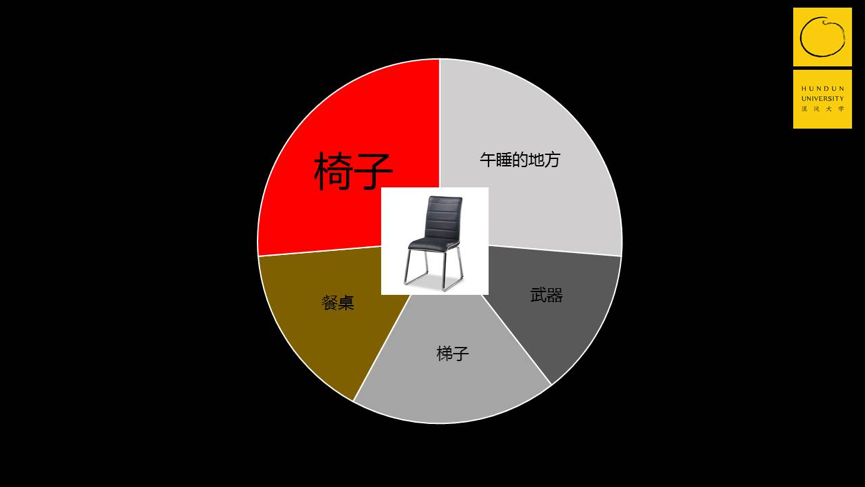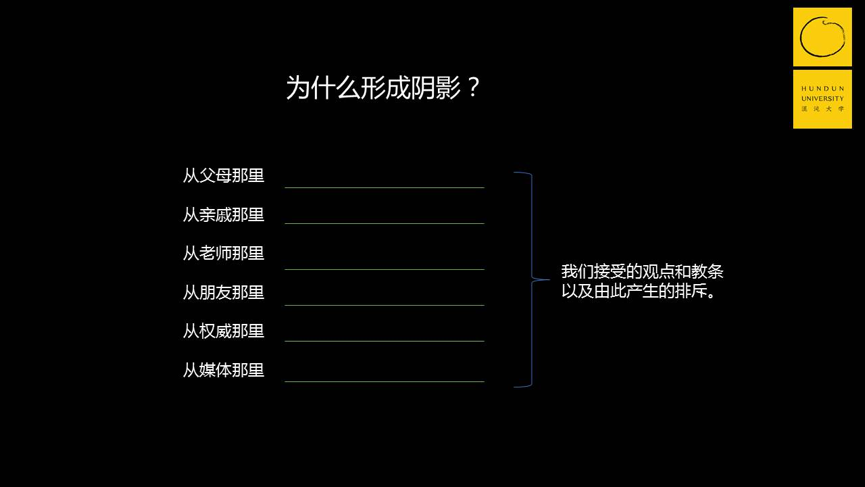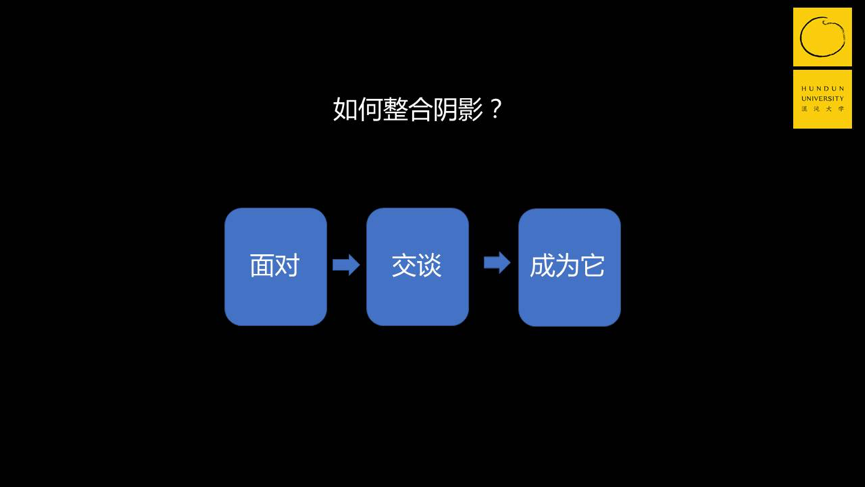Beyond binary opposition.
Editor’s note: This article comes from the WeChat public account “Chaotic University” (ID: hundun-university ) , author Zhu Dan.

Going beyond binary opposition is a big issue. Today we try to understand in the field of personal growth and business management.
The “other side” that you hate and reject must not be put there or hidden, but must be integrated. Otherwise, you may become a slave yourself, and the reason why the enterprise enters a dead end is because it …
“Dark side” needs to be integrated, Otherwise it takes attention
Let ’s take a look, what is this?

Everyone says this is a chair.
In addition to being a chair, what is it? It can be a dining table, used for eating; it can be a ladder, used for food; it can be a weapon for beating people; it can also be a place for nap.

If you say it is a chair, you will wipe out all the possibilities except the chair. This is the deviation that the cognition of symbols brings to the cognition of this world.
When we define a thing as A, we cannot see the other side of the thing.
This is very important for us to understand binary opposition today.
Why are there binary oppositions? When humans do not recognize this world, the world is unique and whole. When humans began to recognize the world, there was a binary opposition.
All wise men are telling people the truth: in personal growth, the most important principle is integration. Integrated means comprehensive and comprehensive. When people think, feel or act in an integrated way, they will bring a sense of integrity and fulfillment to themselves.
And when people are not in a state of integration, it is accompanied by a sense of lack.
For example, role anxiety. Many people regard work as their only role, but in fact we are born to be humans and have many, many roles. When we put all our attention on one role, if you don’t get external evaluation of this job, or if your work and entrepreneurship fail, you will feel like the sky is falling.

There is a concept in psychology called the “dark side”, that is, the shadow, which is the part we divide, reject, deny, and hide; and the part we project to others, such as hating others; or us The part that must be cut off from it.
For example, if a person hates his indecision, indifference, laziness, pursuit of stability and security, then part of him is in the shadows.
So, where the shadow is, let ’s hide it, shall we? I tell everyone, it won’t work. Because maintaining shadows is a high-intensity task, humans need a lot of energy to cover up the unwanted side. So Jung has a sentence: When we are hiding a secret, we put ourselves in a state of self-blame and inferiority.
So, consolidate shadows.
The purpose of integrating shadows is to release the energy of wrestling with imaginary enemies and bring them back to yourself.
When you are in good health, you will rememberDoes your body exist? No way. When we have uncomfortable arms and uncomfortable heads, you remember that I still have arms! In the same way, we can’t remember the side we agree with, but what we remember is our laziness and how to deal with it, which is the most consuming of our attention.
Our attention is used either to create, or to judge and blame ourselves every day. If there are often many voices in the brain, they will fight: on one side I am lazy; on the other side I am diligent! I am lazy; I am diligent! … This is the struggle every day.
But the method of verifying first-class intelligence is to see whether it can simultaneously consider two opposing views in the brain and manage the situation with ease. Latency and hard work are present. They are good friends and they hold hands.
There is no room for free choice, essentially a slave
We will solve it step by step.
First of all, why is there a shadow? Usually comes from 6 aspects:
Parents, relatives, teachers, friends, authority, media. They formed a lot of opinions, dogmas, and those aspects that we hated and rejected.

For example, many of our opinions come from the media, and it has had a great impact on us. Then we have to manage the fragmented and absolute information obtained from the outside world. Therefore, you should stop looking at the voices of some media, and look at some more authoritative and constructive opinions.

There are nine basic types of emotions we form: fear, anger, shock, disgust, sadness, guilt, love, joy, and curiosity.
Then I will ask everyone: What emotions do you like? What emotions do you dislike? Some people say that I like love, joy, curiosity, and hate fear and anger. But we also know that anger is part and parcel of our emotions. Whether you hate it or not, it’s there in anger.
I had no way to connect with my anger before. Because when I was a kid, I was not allowed to be angry. when weWhen there are some dissatisfaction, they may be scolded and scolded by their parents, so that the anger can be withdrawn. Others will tell you that anger is bad, etc. Therefore, our anger can’t be expressed and hidden.
I used to have a colleague who was very angry. I often saw him yelling in the office, and the emotion came up. ——Because I particularly hate angry people, I suppress my anger.
However, when we integrate our shadows, an important method is: What kind of person do you hate? You will integrate with him. That part is the part of energy in your shadow that suppresses and denies.
In the past, I ran, and I escaped. I did n’t want to be with such an angry person. I was so uncomfortable when I saw him, and my liver hurts. But now, I will face this colleague and talk to him. Conversation includes two points of view in our own minds, asking more questions, listening more, and empathizing.
I asked him, why are you so angry? Through in-depth communication, I realized that no one listened to him when he was not angry since he was a child. In the company, he was not angry or nobody paid attention to his point of view. Only through anger did he have the right to express himself freely.

So I knew it, and I accepted this view. Now, I have added another point: I can be angry, and through anger, I can express myself freely.
In the past, all my anger was suppressed, but where did the anger go? It became a lot of sad emotions. Now, I accept anger. In my entire concept, I can be both peaceful and angry. Both views exist in my mind at the same time.
I will give you a good integrated map, called the polar flow map.

This is an infinite symbol. It is precisely through such integration that we can have unlimited and all.
We put the two opposing points of view in the center of our mind, and then look for three advantages and disadvantages. When we see the panorama, we can redefine this matter.
So, my entire cognitive boundary is opened, and at the same time I have the freedom to choose. I can choose anger or peace at different times. This is my free choice, not something that the outside world requires me to have to do.
This makes me think, what is the nature of slaves? The essence of slaves has no right to choose. Then you look at yourself.
When a person is often in a state of having to be helpless and very helpless, the back shows that you may be in a binary opposition.
Because there is only one point of view, one possibility, one label, one opinion in your mind, no other possibilities are allowed, so you will often be in a state of being forced and helpless.
So what is the nature of freedom? It is to give us more possibilities of choice, especially when we can coexist in the mind with two opposing views, when we can do this and that, we are fully free.
Why do many people in this era say that I want to be free, and I want to be free? He went to Africa and climbed the Himalayas, still not free? Because he is still in a state of binary opposition and has no choice.
Former South African President Mandela can have freedom in his 27 years of prison life. This is how he truly understands the essence of freedom.
What are your implicit assumptions? What is the moment of failure?
Now enter the case of company management.
One entrepreneur is an e-commerce company, and the company has one or two hundred people. He said: This year has been very distressing. I am now in order to survive, I have to let different projects compete with each other, or even evolve into a battle. How to do? I have been awake all night.
His distress must come from an implicit assumption inside.
So we have to ask ourselves: what implicit assumptions have I made about this matter? And when is the moment of failure of this hypothesis?
The entrepreneur said:
1. Only when the team is under high pressure and high competition can the company develop well. –is that true? Its failure moment is: when employees need freedom and create an atmosphere, high pressure does not work.
2. Only when employees sacrifice personal time and life can the company develop well. –right? When the company has no way to provide the right direction, or the entire management is ineffective, it is impossible to sacrifice personal time.
3. When there is no competition, employees will have no pressure and will slack off, and the company’s performance will decline. –really? When employees can set their own goals, itThen it failed. Everyone will fight for their own mission and for their own goals.
4. The company’s performance is good, employees’ income increases, and employees will be happy. –is that true? No, the failure time is when employees do not want this growth and materiality. The boss likes it, but I do n’t want it as an employee.
So, in his implicit belief, the core point of view is: the company is a machine, employees are tools, the company is a constantly rotating, need to manage and control a layer of money-making machines to squeeze employees.
And at the moment of failure, the belief is: the company is life, it is an organism, it can operate on its own, and can find a dynamic strategy by itself; and the employee is a complete person, not only pursuing material, but also spirit, employees have their own The goal of struggle, the goal of life.
This is the conflict between his two inner beliefs.
This is a management dilemma. However, with in-depth exploration, a new management system can appear:
It can have free choice. It can make the company a machine or a life entity, and it can take different choices at different times.
Huawei has a 1130 sunset law. When a new system is promulgated, the original two systems will be abolished. It turns out that many systems make the company a machine, and everyone keeps PK; but now it is gradually adjusted, it can be freely chosen. It can become 80%, 60% machine type, and then continue to integrate. Different scenarios and different crowds can make different choices.
To provide you with a method of integration, that is, Ken Wilbur ’s four quadrants of integration, which can integrate everything. In these four quadrants, there are 4 dimensions: individual, collective, inner and outer.

Today, we have seen a more comprehensive perspective, both internally and externally.
In our company management, it is necessary to break this violent way. It needs both profits and something other than profits; it requires both long-term investment and short-term performance; it must emphasize that the company has a business philosophy and must have good daily execution, so that contradictions can coexist and prosper .
So Ren Zhengfei has grayscale management, that is, there is 1000 degrees of gray between black and white. Think about it, is there only black and white between your black and white? Or is there only a small space in the middle?
In the process of our self-growth, we have to keep expanding-expandingExpand our cognition and expand our space so that we can go from low to high dimensional from local to overall.
Finally, can we do this once and for all? In fact, No, this world is not forever. We are always in contradiction. Every viewpoint and every force inevitably breeds its opposite.
When a certain two unites, it becomes a united body, and another contradiction body will be spawned.
So, this requires us to learn to manage binary oppositions, go beyond binary oppositions, and not look at problems in a confrontational perspective.




Now enter the case of company management.
One entrepreneur is an e-commerce company, and the company has one or two hundred people. He said: This year has been very distressing. I am now in order to survive, I have to let different projects compete with each other, or even evolve into a battle. How to do? I have been awake all night.
His distress must come from an implicit assumption inside.
So we have to ask ourselves: what implicit assumptions have I made about this matter? And when is the moment of failure of this hypothesis?
The entrepreneur said:
1. Only when the team is under high pressure and high competition can the company develop well. –is that true? Its failure moment is: when employees need freedom and create an atmosphere, high pressure does not work.
2. Only when employees sacrifice personal time and life can the company develop well. –right? When the company has no way to provide the right direction, or the entire management is ineffective, it is impossible to sacrifice personal time.
3. When there is no competition, employees will have no pressure and will slack off, and the company’s performance will decline. –really? When employees can set their own goals, itThen it failed. Everyone will fight for their own mission and for their own goals.
4. The company’s performance is good, employees’ income increases, and employees will be happy. –is that true? No, the failure time is when employees do not want this growth and materiality. The boss likes it, but I do n’t want it as an employee.
So, in his implicit belief, the core point of view is: the company is a machine, employees are tools, the company is a constantly rotating, need to manage and control a layer of money-making machines to squeeze employees.
And at the moment of failure, the belief is: the company is life, it is an organism, it can operate on its own, and can find a dynamic strategy by itself; and the employee is a complete person, not only pursuing material, but also spirit, employees have their own The goal of struggle, the goal of life.
This is the conflict between his two inner beliefs.
This is a management dilemma. However, with in-depth exploration, a new management system can appear:
It can have free choice. It can make the company a machine or a life entity, and it can take different choices at different times.
Huawei has a 1130 sunset law. When a new system is promulgated, the original two systems will be abolished. It turns out that many systems make the company a machine, and everyone keeps PK; but now it is gradually adjusted, it can be freely chosen. It can become 80%, 60% machine type, and then continue to integrate. Different scenarios and different crowds can make different choices.
To provide you with a method of integration, that is, Ken Wilbur ’s four quadrants of integration, which can integrate everything. In these four quadrants, there are 4 dimensions: individual, collective, inner and outer.

Today, we have seen a more comprehensive perspective, both internally and externally.
In our company management, it is necessary to break this violent way. It needs both profits and something other than profits; it requires both long-term investment and short-term performance; it must emphasize that the company has a business philosophy and must have good daily execution, so that contradictions can coexist and prosper .
So Ren Zhengfei has grayscale management, that is, there is 1000 degrees of gray between black and white. Think about it, is there only black and white between your black and white? Or is there only a small space in the middle?
In the process of our self-growth, we have to keep expanding-expandingExpand our cognition and expand our space so that we can go from low to high dimensional from local to overall.
Finally, can we do this once and for all? In fact, No, this world is not forever. We are always in contradiction. Every viewpoint and every force inevitably breeds its opposite.
When a certain two unites, it becomes a united body, and another contradiction body will be spawned.
So, this requires us to learn to manage binary oppositions, go beyond binary oppositions, and not look at problems in a confrontational perspective.